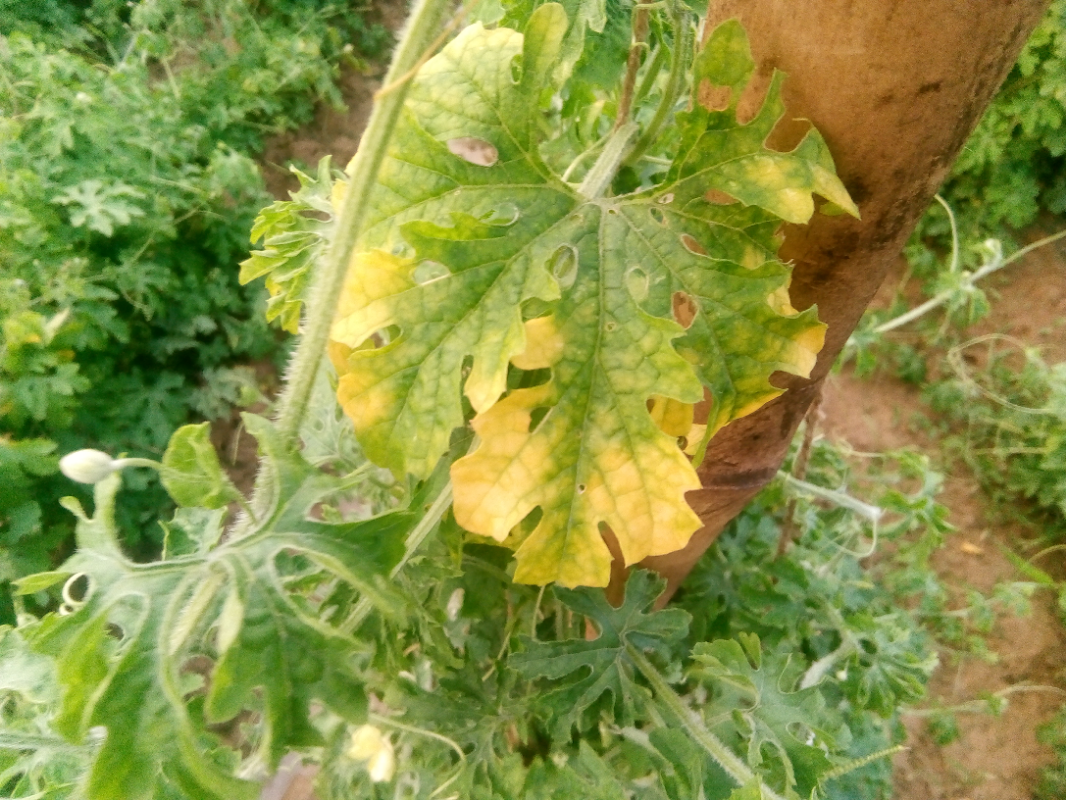Bitter gourd infection
Symptoms Bankura,India
yellowish color starting from leaf margin. Please find out the problem
Posted
by: Sourav Daripa
(1 point)
![]()
Posted: May 18, 2019
Answers
Discoloration of leaves at the edges typically indicates some physiological stress such as lack of key nutrients. Have you had a period of low or too high water? What if any fertilizer have you applied?
It is hard to say what the problem is: possible problems are Chloride toxicity or Boron deficiency https://www.slideshare.net/AllahDadKh...
It would be very good to do a soil test if you can
Have you grown gourds in this spot before?
It is hard to say what the problem is: possible problems are Chloride toxicity or Boron deficiency https://www.slideshare.net/AllahDadKh...
It would be very good to do a soil test if you can
Have you grown gourds in this spot before?
Posted
by: David Hughes
(67 points)
![]()
Posted: May 18, 2019
Nutrient deficiency is the most likely cause of the symptom.
Posted
by: Gure Tumae
(1 point)
![]()
Posted: May 20, 2019
Yellowing foliage (particularly on old growth) with yellow veins, is a symptom of nitrogen deficiency, although it can sometimes affect the whole leaf. However, potassium deficiency can cause the foliage (also primarily the old growth) to yellow around the edges of the leaves. If the plants are weak and easy to break, they probably need potassium. If the leaves are a dull color, they probably need nitrogen (the leaves tend to get dull before the leaves start to yellow—not after). Plants with plenty of nitrogen tend to have shiny (or at least shinier) leaves. Plants with plenty of potassium tend to be very tough to break, and don't bend as easily (stems, roots, and to a lesser degree, leaves). It's possible your plants might need both nutrients.
I don't think you have an infection here. I think it's just potassium and/or nitrogen deficiency. Other things are possible, though. Some infections can cause nutrient deficiencies. I do see some minor leaf curling; so, maybe.
For potassium, I've had the best success with the following (you don't need to use all three):
* Potassium sulfate
* Wood ash (provided the soil isn't too alkaline; it can raise the pH)
* Monopotassium phosphate (this also provides phosphorus)
For nitrogen, most general purpose full fertilizers that are fit for vegetables are probably a good source, but I tend to use ammonium sulfate and/or urea and/or monoammonium phosphate (which only has a little nitrogen and a lot of phosphorus), if I need something water soluble. I'm not sure what I would recommend in the way of a quick organic solution off-hand.
If you're getting nutrient deficiency symptoms in your outdoor soil, you might have an issue with the pH of your soil. Testing it might be a good idea.
Here are some other nutrient issues to look out for in the future:
If the leaves are unusually small or if they are purple underneath, they may need phosphorus. Phosphorus is especially useful for plants when it's cold.
If the fruits are particularly small, that may indicate a potassium or phosphorus deficiency.
If the leaves (primarily on older growth) are yellowing, but the veins are green, then it could be magnesium deficiency.
If the undersides of the leaves look kind of purple-ish and maybe a little translucent, it could be sulfur deficiency. Sulfur deficiency can also cause yellowing of leaves on new growth, much as iron deficiency.
I don't think you have an infection here. I think it's just potassium and/or nitrogen deficiency. Other things are possible, though. Some infections can cause nutrient deficiencies. I do see some minor leaf curling; so, maybe.
For potassium, I've had the best success with the following (you don't need to use all three):
* Potassium sulfate
* Wood ash (provided the soil isn't too alkaline; it can raise the pH)
* Monopotassium phosphate (this also provides phosphorus)
For nitrogen, most general purpose full fertilizers that are fit for vegetables are probably a good source, but I tend to use ammonium sulfate and/or urea and/or monoammonium phosphate (which only has a little nitrogen and a lot of phosphorus), if I need something water soluble. I'm not sure what I would recommend in the way of a quick organic solution off-hand.
If you're getting nutrient deficiency symptoms in your outdoor soil, you might have an issue with the pH of your soil. Testing it might be a good idea.
Here are some other nutrient issues to look out for in the future:
If the leaves are unusually small or if they are purple underneath, they may need phosphorus. Phosphorus is especially useful for plants when it's cold.
If the fruits are particularly small, that may indicate a potassium or phosphorus deficiency.
If the leaves (primarily on older growth) are yellowing, but the veins are green, then it could be magnesium deficiency.
If the undersides of the leaves look kind of purple-ish and maybe a little translucent, it could be sulfur deficiency. Sulfur deficiency can also cause yellowing of leaves on new growth, much as iron deficiency.
Posted
by: Shule
(1 point)
![]()
Posted: May 23, 2019
You need to log in if you'd like to add an answer or comment.



0 Comments